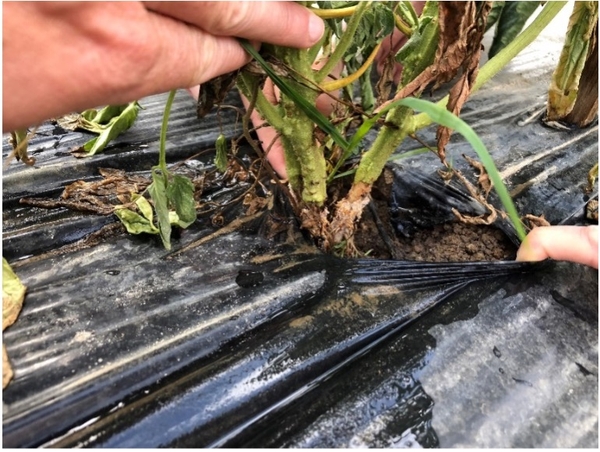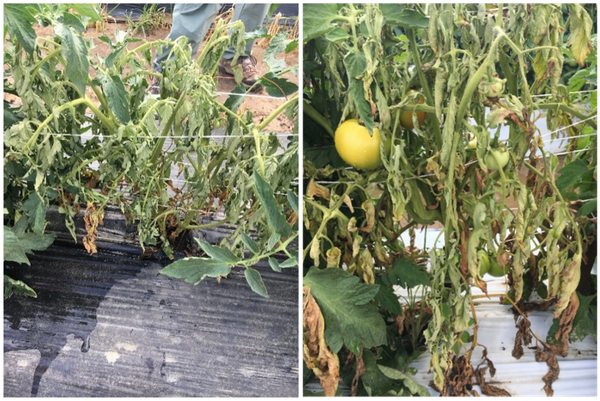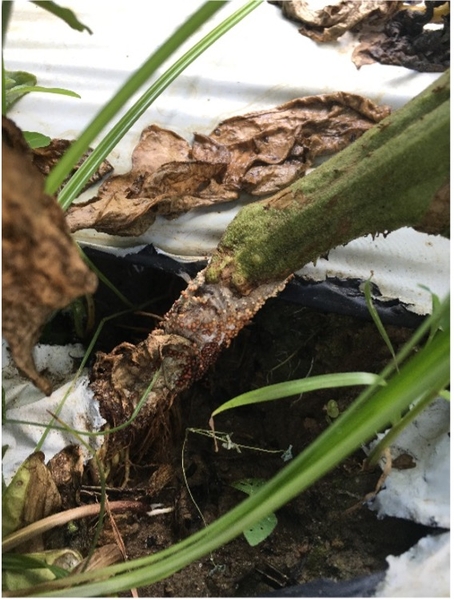General Information
Southern blight, also known as southern wilt and southern stem rot, is a serious and frequent disease of vegetable crops in North Carolina. The disease was first reported on tomato, but also occurs on hundreds of other economically important crops including pepper, bean, cantaloupe, carrot, potato, sweetpotato, watermelon, cotton, peanut, tobacco, and soybean. High temperatures (77 to 95 ℉), aerobic and moist conditions, and acidic soil favor disease development. In North Carolina, the disease will first appear in “hot spots” in fields in early to mid-summer and progress until cooler, dryer conditions prevail.
Pathogen
Southern blight is caused by the soil-born fungus Agroathelia rolfsii (=Sclerotium rolfsii).
Symptoms and Signs
On tomato and pepper, the most common symptom occurs on the lower stem where it is in contact with the soil. Initially, a brown to black lesion usually develops on the stem near the soil line. The lesion will develop rapidly and can completely girdle the stem, which will cause a sudden and permanent wilt of all above ground parts. Young plants may fall over at the soil line.
Under moist conditions, white mycelium will typically develop on stem lesions and can sometimes extend several centimeters up the stem of tomato and pepper plants. After a few days, tan to reddish-brown, spherical sclerotia (1 to 2 mm in diameter) can appear on the mat of mycelia.
The fungus can easily infect fruit that are in contact with infested soil. Lesions will initially appear as sunken and slightly yellow areas that later become water-soaked, soft, and star-shaped spots. The fruit will collapse within 3 to 4 days and white mycelium and sclerotia can fill the lesion cavity. There is no offensive odor associated with rotted fruit or at least initially.
Disease Cycle and Epidemiology
A. rolfsii can survive and overwinter as sclerotia and on host debris in the soil for years. The fungus is highly saprophytic and can produce mycelial growth on a variety of host substrates. However, the fungus is generally restricted to the upper 2 to 3 inches of soil and will not survive at deeper depths. In most North Carolina soils, the fungus does not survive in significant numbers when a host is absent for two years or more. High temperatures (77 to 95 ℉), aerobic and moist conditions, and acidic soil favor disease development and fungal growth. Germination of sclerotia occurs at pH 2-5 and is inhibited at pH higher than 7. Sclerotia are spread by the movement of infested soil and plant material.
General Disease Management
Southern blight can be difficult to manage when inoculum density is high and environmental conditions favor disease development. However, losses can be reduced by adopting the following management strategies:
- Avoid planting in fields with a history of southern blight.
- Rotate host crops with corn, wheat, barley, or other non-host crops to reduce inoculum levels in soil.
- Modify planting dates to avoid conditions that favor disease development, when possible.
- Inoculum levels can be reduced by burying infected plant debris and sclerotia via deep plowing to invert the soil.
- Ensure the previous crop is decomposed prior to planting. This may require disking the field several times in the fall and in the spring.
- Remove symptomatic plants and reduce or eliminate weed populations.
- Maintain adequate soil pH for optimum plant growth. Lower soil pH will encourage disease.
- Tomato varieties grafted onto tomato rootstocks 'Maxifort', 'Big Power', and 'Beaufort' have been shown to maintain high yields in southern-blight infested fields in one study.
Disease Control for Conventional Growers
Several fungicides are labeled for use on tomato and pepper to manage southern blight (Table 1). For the latest fungicide recommendations for southern blight of tomato and pepper, see the Southeastern US vegetable Crop Handbook. Fungicide labels are legal documents—always read and follow fungicide labels.
The fumigation of soils with broad spectrum chemicals such as chloropicrin and sodium metam sodium can reduce disease incidence, but this strategy is limited by economic considerations. Soil fumigants must be applied days to weeks prior to planting.
|
Active Ingredient |
Product |
PHI (day) |
Group1 |
Crop(s) |
|
Difenoconazole + benzovindiflupyr |
Aprovia Top |
0 |
7 + 3 |
Tomato |
|
Fluoxastrobin |
Aftershock Evito 480 SC |
3 |
11 |
Tomato Pepper |
|
Fluxapyroxad + pyraclostrobin |
Priaxor 500 SC |
7 |
7 + 11 |
Tomato Pepper |
|
Penthiopyrad |
Fontelis |
0 |
7 |
Tomato Pepper |
|
Pyraclostrobin |
Cabrio EG |
0 |
11 |
Tomato Pepper |
1FRAC code (fungicide group).
2Blocker has caused stunting on tomato plants when applied at transplant.
Useful Resources
- The NC State University Plant Disease and Insect Clinic provides diagnostics and control recommendations
- The Extension Plant Pathology Portal provides information on crop disease management
- The Southeastern US vegetable Crop Handbook provides information on vegetable disease management
- The USDA Fungus-Host Distributions Database provides information about reported hosts for fungal and oomycete pathogens
Acknowledgments
This disease fact sheet was prepared by the Meadows Plant Pathology Lab.
Funding for updating this fact sheet comes from the United States Department of Agriculture (USDA)-National Institute of Food and Agriculture (NIFA) (2017-70006-27141).
References
Rivard, C. O'Connell, S. Peet, M., and Louws, F. 2010.Grafting toato with interspecific rootstock to manage diseases caused by Sclerotium rolfsii and southern root-knot nematode. Plant Dis. 94:1015-1021.
Publication date: Jan. 17, 2019
Reviewed/Revised: May 28, 2020
N.C. Cooperative Extension prohibits discrimination and harassment regardless of age, color, disability, family and marital status, gender identity, national origin, political beliefs, race, religion, sex (including pregnancy), sexual orientation and veteran status.
Recommendations for the use of agricultural chemicals are included in this publication as a convenience to the reader. The use of brand names and any mention or listing of commercial products or services in this publication does not imply endorsement by NC State University or N.C. A&T State University nor discrimination against similar products or services not mentioned. Individuals who use agricultural chemicals are responsible for ensuring that the intended use complies with current regulations and conforms to the product label. Be sure to obtain current information about usage regulations and examine a current product label before applying any chemical. For assistance, contact your local N.C. Cooperative Extension county center.
N.C. Cooperative Extension prohibits discrimination and harassment regardless of age, color, disability, family and marital status, gender identity, national origin, political beliefs, race, religion, sex (including pregnancy), sexual orientation and veteran status.




